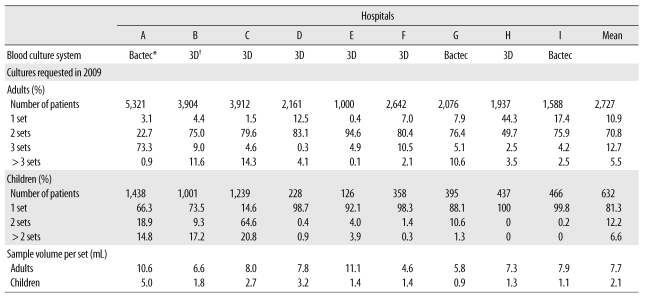1. Reimer LG, Wilson ML, Weinstein MP. Update on detection of bacteremia and fungemia. Clin Microbiol Rev. 1997; 10:444–465. PMID:
9227861.

2. Martin GS, Mannino DM, Eaton S, Moss M. The epidemiology of sepsis in the United States from 1979 through 2000. N Engl J Med. 2003; 348:1546–1554. PMID:
12700374.

3. Clinical and Laboratory Standards Institute. Principles and procedures for blood cultures: approved guideline. M47-A. 2007. Wayne, PA: Clinical and Laboratory Standards Institute.
4. Hall KK, Lyman JA. Updated review of blood culture contamination. Clin Microbiol Rev. 2006; 19:788–802. PMID:
17041144.

5. Ilstrup DM, Washington JA 2nd. The importance of volume of blood cultured in the detection of bacteremia and fungemia. Diagn Microbiol Infect Dis. 1983; 1:107–110. PMID:
6370560.

6. Cockerill FR 3rd, Wilson JW, Vetter EA, Goodman KM, Torgerson CA, Harmsen WS, et al. Optimal testing parameters for blood cultures. Clin Infect Dis. 2004; 38:1724–1730. PMID:
15227618.

7. Bouza E, Sousa D, Rodríguez-Créixems M, Lechuz JG, Muñoz P. Is the volume of blood cultured still a significant factor in the diagnosis of bloodstream infections? J Clin Microbiol. 2007; 45:2765–2769. PMID:
17567782.

8. Lee A, Mirrett S, Reller LB, Weinstein MP. Detection of bloodstream infections in adults: how many blood cultures are needed? J Clin Microbiol. 2007; 45:3546–3548. PMID:
17881544.

9. Weinstein MP, Towns ML, Quartey SM, Mirrett S, Reimer LG, Parmigiani G, et al. The clinical significance of positive blood cultures in the 1990s: a prospective comprehensive evaluation of the microbiology, epidemiology, and outcome of bacteremia and fungemia in adults. Clin Infect Dis. 1997; 24:584–602. PMID:
9145732.

10. Alfa M, Sanche S, Roman S, Fiola Y, Lenton P, Harding G. Continuous quality improvement for introduction of automated blood culture instrument. J Clin Microbiol. 1995; 33:1185–1191. PMID:
7615727.

11. Schifman RB, Strand CL. Blood culture contamination data analysis and critique. Q-Probes. 1995. Chicago: College of American Pathologists;p. 1–19.
12. Eskira S, Gilad J, Schlaeffer P, Hyam E, Peled N, Karakis I, et al. Reduction of blood culture contamination rate by an educational intervention. Clin Microbiol Infect. 2006; 12:818–821. PMID:
16842584.

13. Ahn GY, Jang SJ, Lee SH, Jeong OY, Chaulagain BP, Moon DS, et al. Trends of the species and antimicrobial susceptibility of microorganisms isolated from blood cultures of patients. Korean J Clin Microbiol. 2006; 9:42–50.
14. Koh EM, Lee SG, Kim CK, Kim M, Yong D, Lee K, et al. Microorganisms isolated from blood cultures and their antimicrobial susceptibility patterns at a university hospital during 1994-2003. Korean J Lab Med. 2007; 27:265–275. PMID:
18094587.

15. Lee JS, Shin JH, Lee K, Kim MN, Shin BM, Uh Y, et al. Species distribution and susceptibility to azole antifungals of Candida bloodstream isolates from eight university hospitals in Korea. Yonsei Med J. 2007; 48:779–786. PMID:
17963334.

16. Kang SH, Kim YR. Characteristics of microorganisms isolated from blood cultures at a university hospital located in an island region during 2003~2007. Korean J Clin Microbiol. 2008; 11:11–17.

17. Kim SY, Lim G, Kim MJ, Suh JT, Lee HJ. Trends in five-year blood cultures of patients at a university hospital (2003~2007). Korean J Clin Microbiol. 2009; 12:163–168.

18. Mylotte JM, Tayara A. Blood cultures: clinical aspects and controversies. Eur J Clin Microbiol Infect Dis. 2000; 19:157–163. PMID:
10795587.

19. Riedel S, Carroll KC. Blood cultures: key elements for best practices and future directions. J Infect Chemother. 2010; 16:301–316. PMID:
20490596.

20. Weinstein MP, Reller LB, Murphy JR, Lichtenstein KA. The clinical significance of positive blood cultures: a comprehensive analysis of 500 episodes of bacteremia and fungemia in adults. I. Laboratory and epidemiologic observations. Rev Infect Dis. 1983; 5:35–53. PMID:
6828811.

21. Roberts FJ. The value of the second blood culture. J Infect Dis. 1993; 168:795–796. PMID:
8354929.

22. Darby JM, Linden P, Pasculle W, Saul M. Utilization and diagnostic yield of blood cultures in a surgical intensive care unit. Crit Care Med. 1997; 25:989–994. PMID:
9201052.

23. Paisley JW, Lauer BA. Pediatric blood cultures. Clin Lab Med. 1994; 14:17–30. PMID:
8181229.

24. Bates DW, Goldman L, Lee TH. Contaminant blood cultures and resource utilization. The true consequences of false-positive results. JAMA. 1991; 265:365–369. PMID:
1984535.

25. Bryan CS. Clinical implications of positive blood cultures. Clin Microbiol Rev. 1989; 2:329–353. PMID:
2680055.

26. Morris AJ, Wilson ML, Mirrett S, Reller LB. Rationale for selective use of anaerobic blood cultures. J Clin Microbiol. 1993; 31:2110–2113. PMID:
8370738.







 PDF
PDF ePub
ePub Citation
Citation Print
Print


 XML Download
XML Download